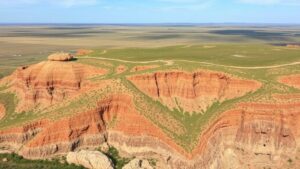Exploring Hidden Canyons for Evidence of Ancient Campsites
Exploring Hidden Canyons for Evidence of Ancient Campsites
The exploration of hidden canyons serves as an invaluable pursuit within the realm of archaeology, particularly in identifying evidence of ancient campsites. Landscapes shaped by millennia of geological and climatic processes reveal rich histories intertwined with the lives of early humans. Uncovering remnants of these campsites provides critical insights into the migratory patterns, lifestyle, and culture of ancient civilizations. This article delves into the methodologies, findings, and significance of exploring hidden canyons to locate these archaeological treasures.
Understanding the Geological Formations
Canyons are typically formed through processes of erosion, primarily caused by water flow over thousands or millions of years. This geographical carving unveils layers of sediment that can contain artifacts from various periods. A well-known example is the Grand Canyon, which exposes rock formations that date back nearly two billion years. Canyons often possess microclimates that were likely favorable for ancient human habitation, providing access to fresh water and abundant resources.
Importance of Geological Layers
The stratification observed in canyon walls serves a critical role in dating ancient artifacts. Each layer corresponds to a specific time period, helping archaeologists establish timelines for human activity. For example, the study of the Chaco Canyon in New Mexico showcases how archaeological findings in sediment layers have enhanced our understanding of the Ancestral Puebloans’ life and architecture. Understanding these geological layers is crucial in identifying not only the location but the age of potential campsites.
Microhabitats as Campsite Evidence
Research indicates that early humans often sought refuge and resources in the sheltered environments of canyons. The presence of microhabitats–specialized ecological spaces that offer favorable conditions–can greatly enhance the likelihood of discovering ancient campsites. For example, areas with natural rock overhangs may have provided protection from the elements, indicating that these locations were strategic choices for prolonged habitation.
Archaeological Techniques and Methodologies
Employing a combination of advanced technologies and traditional techniques, archaeologists conduct rigorous investigations in hidden canyons. e methodologies not only facilitate the discovery of ancient campsites but also contribute to a broader understanding of human behavior in prehistoric contexts.
Remote Sensing Technologies
Remote sensing technologies, such as LiDAR (Light Detection and Ranging), have revolutionized the field of archaeology. By creating detailed topographical maps, LiDAR can help identify potential archaeological features obscured by dense vegetation or difficult terrain. In the case of hidden canyons, this technology has revealed previously unknown structures and pathways, leading to the discovery of ancient campsites.
Field Survey and Excavation
Field surveys remain indispensable in the quest for ancient campsites. Systematic sampling and surface collection techniques enable archaeologists to gather data from areas of interest. For example, the examination of lithic (stone) tools in the Lee Canyon of Nevada has unveiled important insights into Native American subsistence and settlement patterns. Excavation of identified sites allows researchers to glean concrete evidence such as fire pits, tool-making debris, and ceramic fragments.
Case Studies: Discoveries in Hidden Canyons
Several noteworthy discoveries in hidden canyons underscore the importance of this archaeological pursuit. e case studies provide a deeper understanding of early human life while showcasing the potential for future discoveries in less-explored regions.
The Ancestral Puebloans of Mesa Verde
The Mesa Verde region in Colorado is famous for its cliff dwellings, yet the surrounding canyons hold much evidence of the Ancestral Puebloans extensive campsites. In recent excavations, researchers have uncovered tools and food remains, indicating communal living and sophisticated agricultural practices. The study of these campsites sheds light on how ancient peoples adapted to changing environmental conditions over centuries.
Indigenous Cultures of the Pacific Northwest
The canyons of the Pacific Northwest have also revealed substantial archaeological findings. Research led by the University of Oregon has identified ancient fishing camps along riverbanks within hidden canyons. Evidence of fish processing and tool use indicates a well-established culture that relied heavily on aquatic resources. Such findings highlight the relationship between geography and culture in indigenous civilizations.
Significance of Findings
The exploration of hidden canyons for ancient campsites not only enhances our understanding of human history but also has broader implications for contemporary society. By examining how ancient cultures adapted to their environments, we can glean lessons relevant to today’s challenges, such as climate change and sustainable living practices.
Cultural Heritage and Preservation
Preserving ancient campsites is crucial for maintaining cultural heritage. Archaeological findings inform public policy and conservation efforts, ensuring that these significant sites are protected from natural degradation and human impact. Educational programs aimed at raising awareness about these sites foster a shared responsibility for their preservation among local communities and visitors.
Actionable Takeaways
- Explore geological patterns to identify potential archaeological sites, focusing on hidden canyons.
- Use advanced technologies, such as LiDAR, to enhance the discovery process.
- Engage in community-based archaeology that fosters local involvement in preservation efforts.
- Consider the ecological and cultural implications of findings to inform modern practices.
Exploring hidden canyons for evidence of ancient campsites is a complex yet rewarding endeavor. As researchers employ innovative methodologies to uncover these enigmatic sites, the world gains a clearer picture of human history, interconnectedness with nature, and the resilience of ancient cultures. The insights gained not only hold archaeological value but also resonate with contemporary issues, offering lessons that continue to influence our society.



